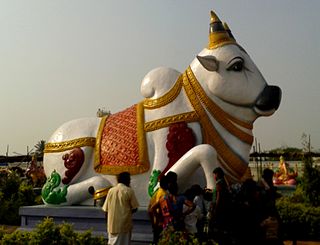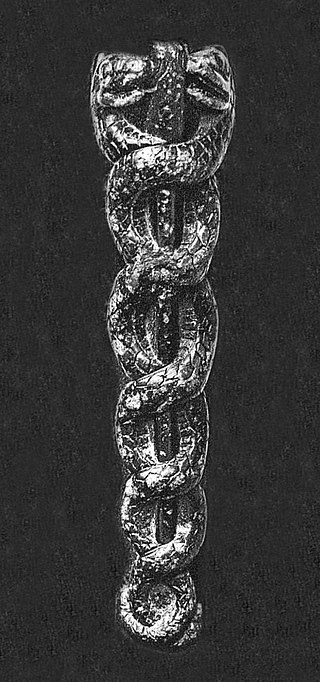Related Research Articles

A goddess is a female deity. In many known cultures, goddesses are often linked with literal or metaphorical pregnancy or imagined feminine roles associated with how women and girls are perceived or expected to behave. This includes themes of spinning, weaving, beauty, love, sexuality, motherhood, domesticity, creativity, and fertility. Many major goddesses are also associated with magic, war, strategy, hunting, farming, wisdom, fate, earth, sky, power, laws, justice, and more. Some themes, such as discord or disease, which are considered negative within their cultural contexts also are found associated with some goddesses. There are as many differently described and understood goddesses as there are male, shapeshifting, or neuter gods.
The serpent, or snake, is one of the oldest and most widespread mythological symbols. The word is derived from Latin serpens, a crawling animal or snake. Snakes have been associated with some of the oldest rituals known to humankind and represent dual expression of good and evil.
In the mythology of the Wunambal people of northwestern Australia, Ungud is a snake god who is sometimes male, sometimes female and sometimes androgynous. He is associated with rainbows by the fact Ungud may be an symbolic representation of rainbows and the fertility and erections of the tribe's shamans. In the beginning, when only the sky and the earth existed, Ungud lived underground as a giant python. Ungud is associated with earth and water and is credited with causing rain to fall and also has connections with monsoons. At night, Ungud and Wallanganda, the sky deity, created living beings through their dreams. The Mother Goddess Kunapipi who is also at times is called the Old Woman is connected to Ungud. The Rainbow Serpent made paths for her to walk around creation. Both The mother goddess and Rainbow serpent are the embodiment of creative powers that live within the earth. Through Ungud Dreaming itself into new forms natural species making it part of what life is based on becoming an archetype of life.

Nehebkau was the primordial snake god in ancient Egyptian mythology. Although originally considered an evil spirit, he later functions as a funerary god associated with the afterlife. As one of the forty-two assessors of Ma’at, Nehebkau was believed to judge the deceased after death and provide their souls with ka – the part of the soul that distinguished the living from the dead.

Animal worship is an umbrella term designating religious or ritual practices involving animals. This includes the worship of animal deities or animal sacrifice. An animal 'cult' is formed when a species is taken to represent a religious figure. Animal cults can be classified according to their formal features or by their symbolic content.

The Rainbow Serpent or Rainbow Snake is a common deity often seen as the creator God, known by numerous names in different Australian Aboriginal languages by the many different Aboriginal peoples. It is a common motif in the art and religion of many Aboriginal Australian peoples. Much like the archetypal mother goddess, the Rainbow Serpent creates land and diversity for the Aboriginal people, but when disturbed can bring great chaos.

Snake worship is devotion to serpent deities. The tradition is nearly universal in the religions and mythologies of ancient cultures, where snakes were seen as the holders of knowledge, strength, and renewal.

Hittite mythology and Hittite religion were the religious beliefs and practices of the Hittites, who created an empire centered in what is now Turkey from c. 1600–1180 BC.

Snakes are a common occurrence in myths for a multitude of cultures. The Hopi people of North America viewed snakes as symbols of healing, transformation, and fertility. Snakes in Mexican folk culture tell about the fear of the snake to the pregnant women where the snake attacks the umbilical cord. The Great Goddess often had snakes as her familiars—sometimes twining around her sacred staff, as in ancient Crete—and they were worshipped as guardians of her mysteries of birth and regeneration. Although not entirely a snake, the plumed serpent, Quetzalcoatl, in Mesoamerican culture, particularly Mayan and Aztec, held a multitude of roles as a deity. He was viewed as a twin entity which embodied that of god and man and equally man and serpent, yet was closely associated with fertility. In ancient Aztec mythology, Quetzalcoatl was the son of the fertility earth goddess, Cihuacoatl, and cloud serpent and hunting god, Maxicoat. His roles took the form of everything from bringer of morning winds and bright daylight for healthy crops, to a sea god capable of bringing on great floods. As shown in the images there are images of the sky serpent with its tail in its mouth, it is believed to be a reverence to the sun, for which Quetzalcoatl was also closely linked.

The sky often has important religious significance. Many religions, both polytheistic and monotheistic, have deities associated with the sky.

A weather god or goddess, also frequently known as a storm god or goddess, is a deity in mythology associated with weather phenomena such as thunder, snow, lightning, rain, wind, storms, tornadoes, and hurricanes. Should they only be in charge of one feature of a storm, they will be called after that attribute, such as a rain god or a lightning/thunder god. This singular attribute might then be emphasized more than the generic, all-encompassing term "storm god", though with thunder/lightning gods, the two terms seem interchangeable. They feature commonly in polytheistic religions, especially in Proto-Indo-European ones.

Inca mythology is the universe of legends and collective memory of the Inca civilization, which took place in the current territories of Colombia, Ecuador, Peru, Bolivia, Chile, and Argentina, incorporating in the first instance, systematically, the territories of the central highlands of Peru to the north.

Kongo religion encompasses the traditional beliefs of the Bakongo people. Due to the highly centralized position of the Kingdom of Kongo, its leaders were able to influence much of the traditional religious practices across the Congo Basin. As a result, many other ethnic groups and kingdoms in West-Central Africa, like the Chokwe and Mbundu, adopted elements of Bakongo spirituality.
References
- 1 2 3 Scheub, Harold (2000). A Dictionary of African Mythology: The Mythmaker as Storyteller. Oxford University Press. pp. 34, 92. ISBN 978-0-19-512456-9.
- 1 2 Auset, Brandi (2009). The Goddess Guide: Exploring the Attributes and Correspondences of the Divine Feminine. Llewellyn Worldwide. p. 40. ISBN 9780738715513.
- ↑ Leeming, David Adams (1996). Goddess: Myths of the Female Divine. Oxford University Press. pp. 97–98. ISBN 9780195104622.
- ↑ Lynch, Patricia Ann (2004). African Mythology A to Z. Infobase Publishing. p. 20. ISBN 9781438119885.
- ↑ "Bunzi Mons". Gazetteer of Planetary Nomenclature.
